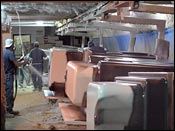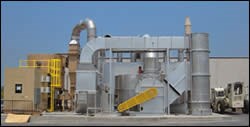Composites and VOCs: Plain and Fancy Ways To Meet Emissions Rules
One year after EPA’s MACT rules took effect, most FRP fabricators have complied via process modifications or low-styrene resins. But some big players have invested in much more elaborate technology.
In 1990, the U.S. Congress enacted the Clean Air Act amendment, a law which directed the Environmental Protection Agency (EPA) to issue new limits on emissions of hazardous air pollutants (HAPs) in many industries, including the composites sector. The EPA directive posed a daunting challenge for composites fabricators that had been accustomed to doing business a certain way for a long time. Now, more than 17 years later, those uncertain and anxious days are a distant memory, as most composites shops now work in full compliance with the EPA rule.
The long and extensive debate between the EPA and the composites industry generated new solutions and practices that have allowed nearly 99% of U.S. composites fabricators to meet the federal environmental requirement, according to Bob Lacovara, technical director of the American Composites Manufacturers Association (ACMA), Arlington, Va. “For 99% of fabricators this is not an issue, but there are a few exceptions,” he says.
Those firms that produce more than 10 tons of volatile organic compound (VOC) emissions per year were required to meet the EPA’s Maximum Achievable Control Technology (MACT) standard by April 21, 2006. Today, most composite firms meet the MACT standard with material and process modifications, while just a few, including a leading bathware manufacturer, have invested in major VOC abatement systems.
Low-HAP resins win out
For most composites firms, there has been basically two ways to reduce VOC emissions such as styrene vapors: Either institute material or process modifications or make a significant capital investment in add-on VOC-abatement equipment. Most have opted to use resins with a low content of hazardous air pollutants (low-HAP) resins and certain manufacturing processes that are known to reduce emissions. These are considered the least expensive routes for FRP fabricators.
Most unsaturated polyester resin and gelcoat suppliers, including Ashland Composite Polymers, AOC LLC, and Reichhold Inc., have developed low-styrene materials that are cost-effective and enable fabricators to meet the emission standards without compromising processability or product quality. Most of these resins offer a range of 32% to 37% styrene content. For maximum effectiveness in VOC reduction, they are paired with low-emissions practices—such as non-atomized spraying for open molding, closed-mold techniques like RTM, and closed die injection instead of open-bath impregnation for pultrusion.
The cost of low-styrene resins is roughly comparable to that of high-HAP materials but in some cases may be slightly higher, says Lacovara. Gelcoat weatherability is improved by lower styrene content, according to suppliers.
One large FRP processor, Molded Fiberglass Companies (MFG), Ashtabula, Ohio, modified its materials and processes to meet the emissions rules. Its six plants, which mold products such as truck parts, radar domes, and wind-energy blades, switched to low-HAP resins, non-atomized spraying, and closed processes to meet MACT standards. “We found these to be the most cost-effective processes that meet the requirements,” said Perry Bennett, MFG’s director of health, safety, and environment.
Similarly, the industry’s largest pultruder, Strongwell Inc., Bristol, Va., has adopted new machine standards to comply with emissions regulations. This manufacturer of structural shapes, channels, oil platforms, and grating uses three techniques to lower emissions by 60%, according to John Barker, corporate manager of environmental affairs. Among them is a specially designed “wet area” enclosure that covers the resin bath and injection die that impregnates the preformed reinforcements.
On the other hand, major BMC and SMC compounders say they have met MACT requirements without making substantial changes in process or materials. One firm (which did not wish to be identified) said that meeting the emissions rules required nothing more than eliminating a cleaning solvent.
VOC-abatement systems
A more capital-intensive method of limiting emissions utilizes VOC-abatement technology commonly used in auto plants to incinerate paint fumes. Such an approach entails an initial investment of at least $1 million as well as ongoing costs. Only a dozen or so composites fabricators have opted for this remedy, according to ACMA’s Lacovara. In most cases, this approach is considered too expensive and a burden on the bottom line.
One major supplier of emissions-control systems, Megtec Systems, DePere, Wis., admits that VOC-abatement equipment has found limited use in composites because of its cost. “If they can change material formulations and maintain quality without adding equipment, it is more cost-effective than making the capital investment,” explains Rod Schwartz, business director.
Among the equipment options are thermal oxidizers—essentially beefed-up heater systems that burn off VOC emissions at 1200 F. A more energy-efficient alternative is a regenerative thermal oxidizer, or RTO, which is a thermal oxidizer that uses ceramic media as a heat exchanger for recovery of combustion heat energy. A third option includes a fume concentrator and an RTO. This two-stage emissions-control system first concentrates the styrene fumes on adsorptive media and then destroys the VOCs in a small oxidizer. The concentrator/RTO system is capital intensive, but its operating costs are lower than those of oxidizers or RTOs alone because the concentrated VOCs make the unit “self-fueling.”
One of the industry’s leading composite bathware manufacturers, Lasco Bathware, Anaheim, Calif., first installed VOC-abatement equipment in 2004 and has since equipped all eight of its U.S. production facilities at a total cost of more than $20 million. The company produces 35% of the FRP residential bathtubs in the U.S.—approximately 151,000 of them per year. Its VOC-abatement systems reportedly destroy a combined total of 250,000 tons/yr of styrene fumes.
After conducting an extensive study, Lasco concluded that VOC abatement would meet OSHA limits on worker exposure to styrene and exceed EPA emissions limits, which would thereby allow Lasco to expand capacity in the future. All this would be possible without compromising its material formulations, says Mike Seymour, v.p. of engineering.
The firm’s Elizabethtown, Pa., plant, which produces 600 bathtubs a day at full capacity on a 24/5 schedule, is representative of Lasco’s MACT-compliance approach. The plant previously employed an old RTO system that was about 70% efficient and highly fuel dependent. Lasco replaced that RTO with the Disc Concentrator System from the Environmental & Energy Systems Div. of Durr Systems.
Less energy required
The Durr system consists of a large, rotating concentrator disk made of zeolite ceramic-based media, which adsorbs incoming VOCs, and a thermal oxidizer where the concentrated VOCs, after being stripped from a portion of the disc, are destroyed at temperatures up to 1600 F or more. The system continuously admits 85,000 cfm of styrene-laden air from the production line, which includes five spray booths, and concentrates the styrene more than tenfold via adsorption onto the disc and then desorption.
The concentrated VOCs stripped from the disc are fed into the RTO, where the styrene is converted into carbon dioxide and water. A portion of the heat released is recovered. This provides enough energy to sustain the operation of the RTO without any additional fuel, says Jason Valia, Durr’s regional sales manager. The typical installed cost of the system is about $15 to $20/cfm of air.
Fume concentration helps minimize fuel costs because only 5% to 20% of the inlet air stream is actually oxidized. Since installing the Durr systems, Lasco has saved an average of $400,000/yr on energy costs.
Lasco claims to have reaped big benefits from the new abatement system, particularly in regard to worker exposure, says Seymour. The use of VOC-abatement equipment has actually allowed for greater use of styrene in resin formulations, boosting the strength and durability of Lasco’s bathware products, he says. Despite the initial capital outlay, Seymour believes that VOC-abatement systems will emerge as a lower-cost option over time. VOC abatement adds about $2 to the cost of each bathtub. Lasco says use of MACT-compliant materials would add $4 per tub in additional costs.
A ‘community’ investment
Meanwhile, Tecton Products LLC, a pultruder based in Fargo, N.D., installed VOC-abatement equipment 15 years ago at its 24/7 operation in Fargo and added a similar system last year at its brand-new facility in Salem, Va. The company, a producer of complex thin-wall profiles for construction and appliances (see p. 112), made the seven-figure investment because MACT compliance was important from “a community and worker” perspective, said Steve Syrdal, sales manager. Tecton opted for add-on control technology despite the fact that industry officials say pultruders have been required only to enclose the wet-out area in order to meet the MACT standard.
Tecton installed an RTO system at both plants. It offered the best operating efficiency and the lowest fuel and maintenance costs of the three commercially available thermal oxidizer technologies, Tecton claims. The RTO destroys more than 95% of VOCs and enables Tecton to “grow its business in an unrestricted fashion,” says Syrdal.
Another user of VOC-abatement equipment is Core Molding Technologies, Columbus, Ohio, a manufacturer of FRP products and compounder of SMC. Core Molding’s processing capabilities include compression molding of SMC, vacuum-assisted resin infusion, spray-up, and hand lay-up. To reduce VOC emissions from its processing and painting operations, Core Molding purchased a skid-mounted CompacTherm RTO from McGill AirClean. The Model MCT10 handles air flows up to 10,000 scfm, according to Tom Maurer, McGill’s manager of technical services.
The RTO incinerates VOCs at 1500 F and provides 95% heat recovery. The heat exchanger consists of a structured ceramic block. McGill RTO units handle air flows from 1000 to 50,000 scfm and prices range from $100,000 to over $1 million.
Related Content
Research Suggests Path From Waste Plastics to High Value Composites
Flash joule heating could enable upcycling of waste plastic to carbon nanomaterials.
Read MoreRead Next
Troubleshooting Screw and Barrel Wear in Extrusion
Extruder screws and barrels will wear over time. If you are seeing a reduction in specific rate and higher discharge temperatures, wear is the likely culprit.
Read MoreAdvanced Recycling: Beyond Pyrolysis
Consumer-product brand owners increasingly see advanced chemical recycling as a necessary complement to mechanical recycling if they are to meet ambitious goals for a circular economy in the next decade. Dozens of technology providers are developing new technologies to overcome the limitations of existing pyrolysis methods and to commercialize various alternative approaches to chemical recycling of plastics.
Read MorePeople 4.0 – How to Get Buy-In from Your Staff for Industry 4.0 Systems
Implementing a production monitoring system as the foundation of a ‘smart factory’ is about integrating people with new technology as much as it is about integrating machines and computers. Here are tips from a company that has gone through the process.
Read More




























